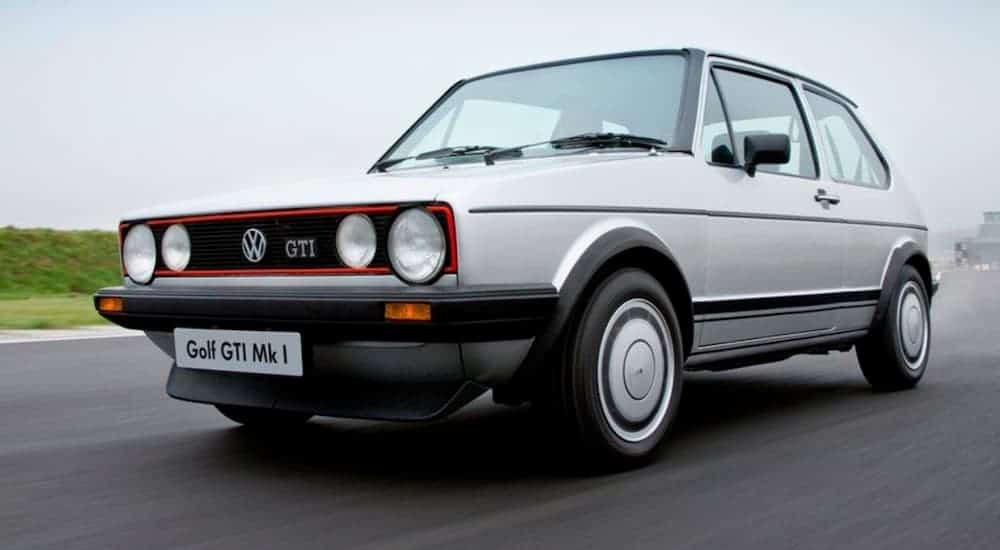Not so long ago, there were numerous choices for a sporty “hot hatch.” But today, the Ford Focus RS, the Subaru WRX hatch, the Mazdaspeed 3, and the Honda Civic Si hatch are all no more. And although the relatively new Honda Civic Type R is certainly an incredible car, it’s higher cost and polarizing style makes it rather ill-suited for daily driving. Fortunately, the original hot hatch remains the Volkswagen Golf GTI.
Although not technically the first entry in the hot hatch segment, the Volkswagen Golf GTI can well be said to be the car that has done the most to popularize it. Over its now forty-four-year history, the Golf GTI has become an icon of sporty yet practical car design. Today we stand on the verge of the newest entry in its legend, as the Mk 8 Golf GTI is set to be released soon for the 2021 model year.
The Debut of a Legend

The original Volkswagen Golf GTI appeared on the market in 1976, two years after the release of the Mk 1 Golf. The “GTI” acronym stands for “Grand Tourer Injection,” and although it has now become near-synonymous with the Golf GTI, it was actually first coined in 1960 by Maserati for its 3500 GTi. Today the “Injection” part of the acronym is mostly superfluous given that nearly every vehicle on the road now has a direct injection engine, but when the Golf GTI was originally introduced, direct injection was a rarity only found in high-performance vehicles.
The reason that the original Golf GTI was given such a good engine (at least by the standards of the day––it was only 109 hp) is because it was a pet project by the Volkswagen engineers rather than a planned part of the Golf line. Indeed, it took some convincing from the designers to get Volkswagen’s leadership to produce the 5,000 cars needed to meet racing homologation requirements. But when the Volkswagen Golf GTI did hit the market, it was a resounding success that sold out within days. By the time production of the Mk 1 Golf GTI ended in 1983, some 461,690 of the powerful little cars had been sold.
Although externally little different from the base Golf, the original Golf GTI introduced several unique visual touches that continue to this day. The red trim in the grille, the golf ball gear shifter, and of course, the plaid seat covers all combined to create a vehicle that instantly stands out to those knowledgeable auto enthusiasts who know what to look for. Interestingly, all three of these distinct touches are credited to Gunhild Liljequist, the lone women on the original Golf GTI design design team. Without her under-recognized contribution, the Golf GTI would not be the vehicle that it is today.
The Golf Evolves
However, the Volkswagen Golf GTI did not arrive in America until 1985 with the Mk 2 version of the car. This was a much larger vehicle than the Mk 1 Golf, having grown from 1,850 pounds to 2,250 pounds. However, the engine was upgraded to keep pace with the growth in size and was now a 1.8L producing similar horsepower but significantly more torque. This allowed the Mk 2 Golf GTI to attain a similar zero to sixty time as well as a higher top speed. Conveniences such as power steering and four-wheel disc brakes were also added.
But in 1997, the Golf GTI came close to dying off after it was reduced to merely a trim option on the Mk 4 Golf. Not only did it lose some of its distinctive looks, but it was also available on cars that lacked a direct injection engine. Fortunately, in 2004, Volkswagen returned to its senses and reintroduced a proper Golf GTI. This Mk 5 version also brought changes of its own. It was the first Golf GTI to use a turbocharged engine (a 2.0L producing 197 hp––a significant leap over the 2.0L naturally aspirated 148 hp engine of the Mk 3), and it was the first time it was offered with an automatic transmission (Volkswagen’s new dual-clutch DSG). Together, these produced a car capable of reaching 60 mph in under 7 seconds, a huge advance over the 10 second times of older Golf GTI’s.
The Golf Today
The current Mk 7 Golf GTI was introduced in 2013 and updated for 2018. It continues to use a 2.0L turbocharged engine, although it now produces an impressive 228 hp and 258 lb-ft of torque. Transmission options are currently either a seven-speed DSG or a six-speed manual. When equipped with the DSG, the Golf GTI has launch control and is capable of reaching 60 mph in well under 6 seconds.
However, as with previous versions of the Volkswagen Golf GTI, the engine is far from the only improvement over the base Golf. The suspension is lowered 0.6-inches, the anti-sway bars have been upgraded to 24 mm in the front and 20 mm in the back and the steering rack was tightened from 2.76 turns to 2.1 turns. Finally, the Golf GTI is equipped with a torque-sensing electronically-controlled limited slip differential, an incredible piece of technology generally only found in much more expensive dedicated sports cars.
Although some may feel that it detracts from the driving experience, the Golf GTI now has several automatic drivers aids and electronic safety features standard. These include collision warning, automatic emergency braking, and blind-spot warnings. On the higher SE trim, there is also optional adaptive cruise control, automatic parking, and automatic headlights. But while the purists may balk at having such features on a performance car, the Golf GTI has never been a pure sports car, and these features make the Mk 7 a much safer vehicle on the street.
Currently, the Volkswagen Golf GTI starts at $28,595 for the six-speed manual, with the DSG being a $1,000 option. Altogether, this makes it an exceptional choice for practical performance with no real competitor currently on the market.
The Future Golf
However, the Mk 7 Golf GTI is set to end production this year and be replaced with the new Mk 8 Golf GTI. The base model Mk 8 Golf was actually released last year in Europe but has not yet found its way to America. In fact, it is increasingly looking as if the Golf GTI will become the base model in the American market, with the even more powerful 288 hp AWD Golf R taking the GTI’s former place as the sportier variant. However, the performance and expected price tag of the Golf R will likely take it out of the world of practical fun and into the realm of cars such as the Civic Type R or the Subaru STI.
So far, the specs of the Mk 8 Golf GTI are still something of a mystery. Aside from pictures showing a clean and modern exterior, very little information has been released. However, rumors are suggesting that the engine will continue to be a 2.0L turbo, albeit one upgraded to produce 241 hp. And although this may become overshadowed by the Golf R, it should easily allow the Mk 8 Volkswagen Golf GTI to shine in the now diminished hot hatch market against competitors like the Hyundai Veloster Turbo or the Honda Civic Hatch Sport.





